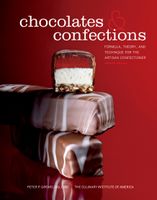Advertisement
Technique: Liquor Cordials
Appears in
By Peter Greweling and Culinary Institute of America
Published 2007
To make starch-molded liquor cordials:
- Prepare Starch Molds in the Desired Shapes. (See Starch-Molding Technique and Theory.) Any shape imprinter desired may be used to make liquor cordials. Because of the centers’ liquid state and relatively high alcohol content, however, excessively large shapes should be avoided, as they are difficult to eat in the requisite one bite. Any time starch is used for molding, it should be well dried prior to use. It is especially imperative that the starch be dried when making liquor cordials. Properly dried starch repels moisture, thus holding the syrup in the prepared cavities. Starch that is not adequately dried attracts moisture, absorbing the syrup before the syrup can form a skin of crystallization.
- Combine the Sugar and Water, and Boil the Syrup to a Supersaturated State Without Adding a Doctoring Agent. Any type of doctoring agent prevents the crystallization on which these confections depend. The temperature to which the syrup is cooked, as well as sugar-cooking technique, is particularly critical for making cordials. An accurate thermometer is a must, as are cleaning the sides of the saucepan and skimming impurities from the syrup as it cooks. Syrup that is overcooked is prone to excessive crystallization, resulting in thick shells or fully crystallized pieces. Conversely, syrup that is undercooked will not form the skin of crystallization that makes these confections possible to handle. Impurities or sugar crystals can induce excessive crystallization of the sugar, causing crystallization of the finished pieces.
- Add a Measured Quantity of Warm Spirit or Liqueur to the Syrup, with Minimal Agitation and Without Allowing the Syrup to Cool Significantly. Excessive agitation while cooling can promote crystallization of the syrup, resulting in fully crystallized centers rather than liquid-filled ones. The liquor brings the syrup just above the point of saturation at room temperature—72° Brix on a refractometer—which allows just a skin of crystallization to form, containing the saturated-syrup center.
- Deposit the Flavored Syrup in the Prepared Starch Molds and Cover it by Sifting a Layer of the Dry Starch Over the Filled Molds. The Molds Should be Fully Buried in the Dry Starch. The dry starch surrounding the syrup performs two vital functions: it acts as a mold, holding the syrup in the desired shape, and the starch granules act as nuclei onto which the sugar will crystallize to form the skin of the centers. It is important to sift the dry starch over the deposited syrup so that the syrup will form crystals on all its surfaces, including the top.
- After Four to Five Hours, Turn the Shells Over in the Starch to Ensure Even Crystallization. Turning the cordials is an optional step, but without it the side that is up in the starch will form a relatively thin shell of sugar crystals and will be more delicate to handle and dip in chocolate. Turning the cordials too early results in excessive breakage of the centers, but waiting too long to turn them defeats the purpose of doing so. The centers should be turned as soon as they can be very gently handled without breaking.
- Twenty-Four Hours After Depositing the Syrup, Remove the Finished Centers and Brush Off the Excess Starch With a Soft, Dry Pastry Brush. The cordials are ready to be dipped in chocolate and decorated as desired, but they must always be handled gently to prevent breaking the thin shell of crystallization.



